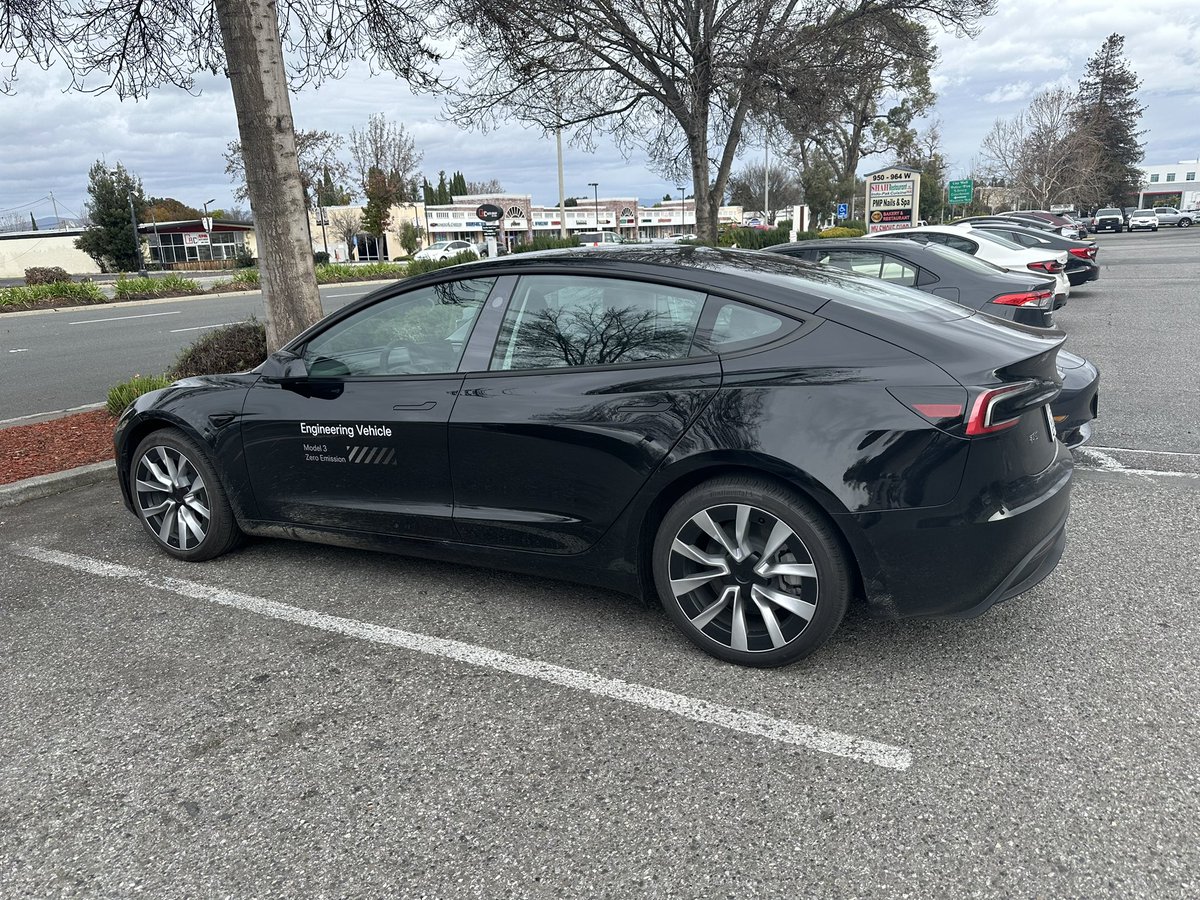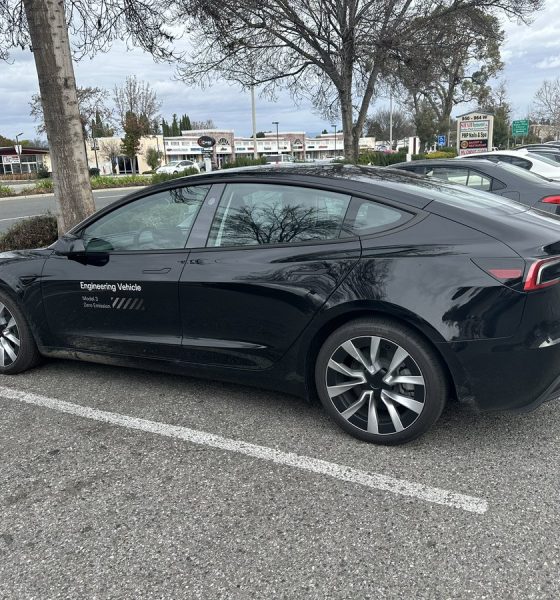

News
Tesla may underpromise and overdeliver with the Model 3 Highland in the US
Tesla has not really “underpromised and overdelivered” since it started deliveries of the Model Y crossover earlier than expected in March 2020. At the time, Tesla had maintained that Model Y deliveries were due in Fall 2020. This same thing may be happening with the upgraded Model 3, better known in EV circles as the Model 3 Highland, in the United States.
The upgraded Tesla Model 3’s Rear Wheel Drive (RWD) and All Wheel Drive (AWD) versions were unveiled in late August 2022, but it soon became evident that the vehicle would only be available in territories that are supplied by Gigafactory Shanghai. The United States, which gets its Model 3 sedans from the Fremont Factory, still received the previous generation Model 3.
Reports also emerged then that the United States would not be getting the Model 3 Highland for a notable amount of time. Optimistic predictions from Tesla watchers suggested a release date for the upgraded vehicle sometime in 2024, while those who were more conservative suggested that the Model 3 Highland could arrive in the US even later. As of late, however, it is starting to seem that Tesla may be ready to release the upgraded Model 3 sooner than expected.
Sunnyvale, CA ? pic.twitter.com/FbRhvuutlV— Sawyer Merritt (@SawyerMerritt) January 7, 2024
Over the past weeks, sightings of fully uncovered Model 3 Highland vehicles have been reported on social media. The vehicles are quite unique, as they feature a Tesla badge written in Chinese characters, making them seem like they were produced at Giga Shanghai. Observations of the Model 3 Highland units’ VINs suggested that the cars were produced in the Fremont Factory, however. Interestingly enough, some of the upgraded Model 3 units were marked as engineering vehicles.
?NEW YEAR NEW FREMONT MODEL 3 ?
This refresh Tesla Model 3 was spotted with Shanghai badges but the VIN shows it was built in Fremont (F factory designation).
Maybe we will see deliveries in Q1 as called by @Scobleizer. https://t.co/D5j4zwXe31 pic.twitter.com/mFUNeD35pj— Matthew Donegan-Ryan (@MatthewDR) January 1, 2024
What is immediately noticeable from the vehicles that have recently been spotted in the United States is the fact that they are already very finely made. This suggests that if the vehicles are indeed manufactured in the Fremont Factory, the facility is already producing upgraded Model 3 units that are ready for customer deliveries. If this were indeed the case, it would not be surprising if customer deliveries of the Model 3 Highland in the United States start earlier than expected, perhaps as early as Q1 2024.
Tesla Model 3 Highland full walk around. I saw this today at the Firebaugh supercharger. #tesla #tsla #model3 #fyp #viral #cybertruck #teslacybertruck pic.twitter.com/Vi7h3u0FIf— Tesla Owners Silicon Valley (@teslaownersSV) December 29, 2023
A hint at such a timeline may have been dropped by Tesla in late November. At the time, Tesla Australia chief engineer and Model 3 program veteran Daniel Ho reportedly remarked that a revamped Model 3 Performance would make its way to Australia in the first half of 2024. The comments suggested that serious developments could be expected in the Model 3 program in early 2024. One of these may very well be the start of the revamped vehicle’s production at the Fremont Factory.
Tesla has been accused of overpromising and underdelivering as of late. Elon Musk’s FSD promises have proven inaccurate time and time again; the Model S Plaid+ was canceled before it was released; the next-generation Roadster is still nowhere to be found; the Semi is still not ramped; progress on Giga Nevada’s expansion and Giga Mexico has been practically nonexistent; and the Cyberbeast’s range is significantly lower than expected despite its notable price hike. If Tesla manages to release the Model 3 Highland earlier than expected in the United States, it could prove that the company can still exceed expectations, especially when it quietly executes on its goals.
Don’t hesitate to contact us with news tips. Just send a message to simon@teslarati.com to give us a heads up.

News
Tesla FSD fleet is nearing 7 billion total miles, including 2.5 billion city miles
As can be seen on Tesla’s official FSD webpage, vehicles equipped with the system have now navigated over 6.99 billion miles.

Tesla’s Full Self-Driving (Supervised) fleet is closing in on almost 7 billion total miles driven, as per data posted by the company on its official FSD webpage.
These figures hint at the massive scale of data fueling Tesla’s rapid FSD improvements, which have been quite notable as of late.
FSD mileage milestones
As can be seen on Tesla’s official FSD webpage, vehicles equipped with the system have now navigated over 6.99 billion miles. Tesla owner and avid FSD tester Whole Mars Catalog also shared a screenshot indicating that from the nearly 7 billion miles traveled by the FSD fleet, more than 2.5 billion miles were driven inside cities.
City miles are particularly valuable for complex urban scenarios like unprotected turns, pedestrian interactions, and traffic lights. This is also the difference-maker for FSD, as only complex solutions, such as Waymo’s self-driving taxis, operate similarly on inner-city streets. And even then, incidents such as the San Francisco blackouts have proven challenging for sensor-rich vehicles like Waymos.
Tesla’s data edge
Tesla has a number of advantages in the autonomous vehicle sector, one of which is the size of its fleet and the number of vehicles training FSD on real-world roads. Tesla’s nearly 7 billion FSD miles then allow the company to roll out updates that make its vehicles behave like they are being driven by experienced drivers, even if they are operating on their own.
So notable are Tesla’s improvements to FSD that NVIDIA Director of Robotics Jim Fan, after experiencing FSD v14, noted that the system is the first AI that passes what he described as a “Physical Turing Test.”
“Despite knowing exactly how robot learning works, I still find it magical watching the steering wheel turn by itself. First it feels surreal, next it becomes routine. Then, like the smartphone, taking it away actively hurts. This is how humanity gets rewired and glued to god-like technologies,” Fan wrote in a post on X.
News
Tesla starts showing how FSD will change lives in Europe
Local officials tested the system on narrow country roads and were impressed by FSD’s smooth, human-like driving, with some calling the service a game-changer for everyday life in areas that are far from urban centers.

Tesla has launched Europe’s first public shuttle service using Full Self-Driving (Supervised) in the rural Eifelkreis Bitburg-Prüm region of Germany, demonstrating how the technology can restore independence and mobility for people who struggle with limited transport options.
Local officials tested the system on narrow country roads and were impressed by FSD’s smooth, human-like driving, with some calling the service a game-changer for everyday life in areas that are far from urban centers.
Officials see real impact on rural residents
Arzfeld Mayor Johannes Kuhl and District Administrator Andreas Kruppert personally tested the Tesla shuttle service. This allowed them to see just how well FSD navigated winding lanes and rural roads confidently. Kruppert said, “Autonomous driving sounds like science fiction to many, but we simply see here that it works totally well in rural regions too.” Kuhl, for his part, also noted that FSD “feels like a very experienced driver.”
The pilot complements the area’s “Citizen Bus” program, which provides on-demand rides for elderly residents who can no longer drive themselves. Tesla Europe shared a video of a demonstration of the service, highlighting how FSD gives people their freedom back, even in places where public transport is not as prevalent.
What the Ministry for Economic Affairs and Transport says
Rhineland-Palatinate’s Minister Daniela Schmitt supported the project, praising the collaboration that made this “first of its kind in Europe” possible. As per the ministry, the rural rollout for the service shows FSD’s potential beyond major cities, and it delivers tangible benefits like grocery runs, doctor visits, and social connections for isolated residents.
“Reliable and flexible mobility is especially vital in rural areas. With the launch of a shuttle service using self-driving vehicles (FSD supervised) by Tesla in the Eifelkreis Bitburg-Prüm, an innovative pilot project is now getting underway that complements local community bus services. It is the first project of its kind in Europe.
“The result is a real gain for rural mobility: greater accessibility, more flexibility and tangible benefits for everyday life. A strong signal for innovation, cooperation and future-oriented mobility beyond urban centers,” the ministry wrote in a LinkedIn post.
News
Tesla China quietly posts Robotaxi-related job listing
Tesla China is currently seeking a Low Voltage Electrical Engineer to work on circuit board design for the company’s autonomous vehicles.

Tesla has posted a new job listing in Shanghai explicitly tied to its Robotaxi program, fueling speculation that the company is preparing to launch its dedicated autonomous ride-hailing service in China.
As noted in the listing, Tesla China is currently seeking a Low Voltage Electrical Engineer to work on circuit board design for the company’s autonomous vehicles.
Robotaxi-specific role
The listing, which was shared on social media platform X by industry watcher @tslaming, suggested that Tesla China is looking to fill the role urgently. The job listing itself specifically mentions that the person hired for the role will be working on the Low Voltage Hardware team, which would design the circuit boards that would serve as the nervous system of the Robotaxi.
Key tasks for the role, as indicated in the job listing, include collaboration with PCB layout, firmware, mechanical, program management, and validation teams, among other responsibilities. The role is based in Shanghai.
China Robotaxi launch
China represents a massive potential market for robotaxis, with its dense urban centers and supportive policies in select cities. Tesla has limited permission to roll out FSD in the country, though despite this, its vehicles have been hailed as among the best in the market when it comes to autonomous features. So far, at least, it appears that China supports Tesla’s FSD and Robotaxi rollout.
This was hinted at in November, when Tesla brought the Cybercab to the 8th China International Import Expo (CIIE) in Shanghai, marking the first time that the autonomous two-seater was brought to the Asia-Pacific region. The vehicle, despite not having a release date in China, received a significant amount of interest among the event’s attendees.








